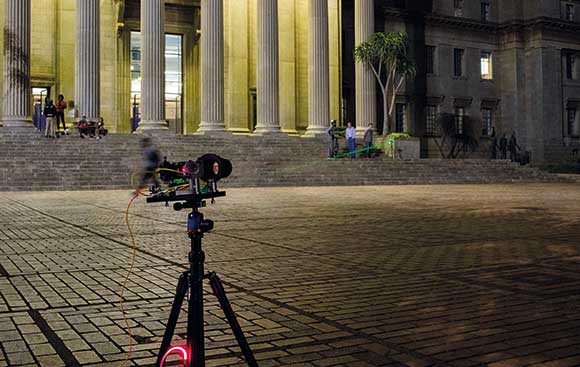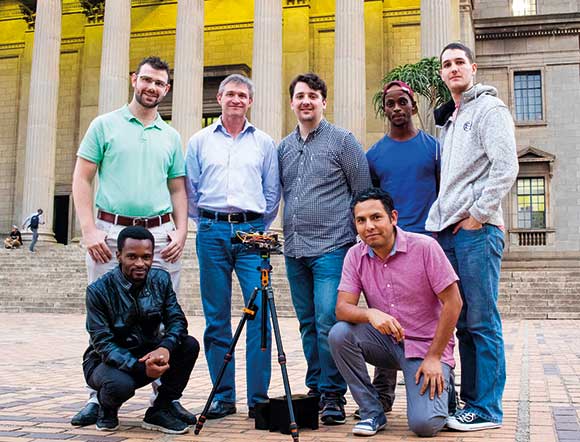Wits researchers look to photonics to bridge digital divide
15 August 2018
Editor's Choice
News
Telecoms, Datacoms, Wireless, IoT
Information from University of the Witwatersrand.
Africa has 20% of the world’s population but only 4% of its Internet data access. This digital divide, with low Internet connectivity reach, particularly in rural areas, is both economic and geographic in nature. A recent report by the UN highlighted that over four billion people in the world are not connected, with Africa having the lowest penetration (22%) and the highest gender divide (25%). The UN further estimates that $400 million (just under R5 billion) allotted to bridging the gender digital divide remains unspent.
A team of international researchers, coordinated by Professor Andrew Forbes from the School of Physics at the University of the Witwatersrand (Wits) and Professor Ling Cheng of the School of Electrical and Information, gathered in South Africa recently to address this problem. Their solutions were published in the international journal Nature Photonics.
A prototype of the device that could connect remote places to fast, reliable Internet is tested by the team at Wits University. Credit: Wits University.
The divide can be broken down into two parts: an affordability gap due to low disposable income, and a geographical gap due to lack of infrastructure. If South Africa’s gap was to be addressed by state-of-the-art optical fibre then an additional 160 000 km of fibre would be needed. This is possible but very expensive. But getting people connected is a priority, particularly for South Africa, where broadband has been estimated to have the potential to raise GDP by R130 billion and create 400 000 jobs.
The Wits team is concentrating on bridging the divide by connecting communities with free-space optical (FSO) links – a network of communication channels through air, much like Wi-Fi but much faster and with a longer reach. “Light holds tremendous promise for fast connections across medium distances,” explains Professor Andrew Forbes, team leader of the collaboration and Distinguished Professor in the School of Physics where he heads up the Wits Structured Light Laboratory. “Even Google, Facebook and SpaceX have exotic proposals for Africa that include drones and other aerial vehicles delivering connections in a blanket manner. We are working on point to point solutions with sustainable photonics that are home-grown.”
A team of Wits physicists and engineers teamed up to build a prototype device aimed at solving Africa’s digital divide. Credit: Wits University.
“Internet is not a luxury but a right,” says Mitchell Cox, a PhD engineering student working on the project. Existing FSO systems are able to comfortably sustain gigabit connection speeds over multi-kilometre distances. “With further research and development into advanced digital signal processing and coding schemes, this may be increased dramatically with relatively little expense,” says Professor Ling Cheng.
The team is working towards a multi-hop FSO link that will cover tens of kilometres across the digital divide. Forbes points out that working with this team of scientists and engineers has allowed some of the most recent scientific findings to be rapidly and efficiently deployed to tackle this challenge. The Wits team has already made several technical advances to address the issues involved and is about to embark on a commercialisation programme with a local listed company.
For more information contact Schalk Mouton, University of the Witwatersrand, +27 11 717 1017, [email protected], www.wits.ac.za
Further reading:
20 years of precision, progress and purpose – the Jemstech journey
Jemstech
Editor's Choice Manufacturing / Production Technology, Hardware & Services
Twenty years ago, Jemstech began as a small, determined venture built on technical excellence and trust. Today, it stands among South Africa’s leading electronic manufacturing service providers.
Read more...
A new era in wire bond inspection
Techmet
Editor's Choice Manufacturing / Production Technology, Hardware & Services
Viscom is developing a 3D wire bond inspection system that incorporates substantially improved sensors, a high image resolution, and fast image data processing.
Read more...
Energy harvesting using a battery-less IoT system
NuVision Electronics
Editor's Choice Power Electronics / Power Management
Energy Harvesting plays an essential role in the foundation of ambient IoT, a new generation of ultra-low power connected devices that operate by drawing energy from their environment instead of relying on traditional batteries.
Read more...
Questing for the quantum AI advantage
Editor's Choice AI & ML
Two quantum experts disclose high hopes and realities for this emerging space.
Read more...
From the editor's desk: Progress meets reality
Technews Publishing
Editor's Choice
In the first half of 2025, renewable energy, incorporating solar, wind, and to a lesser degree hydropower and bioenergy, has generated more electricity globally than coal did.
Read more...
From ER to effortless: The 15-year journey of Seven Labs Technology
Seven Labs Technology
Editor's Choice Manufacturing / Production Technology, Hardware & Services
What started as a business likened to an ‘ER’ for electronic components has today grown into a trusted partner delivering kitting services and full turnkey solutions – taking the effort out of electronics and helping customers truly ‘Move to Effortless.’
Read more...
The trends driving uptake of IoT Platform as a Service
Trinity IoT
Editor's Choice Telecoms, Datacoms, Wireless, IoT
IoT platforms, delivered as a service, are the key that will enable enterprises to leverage a number of growing trends within the IT space, and access a range of benefits that will help them grow their businesses.
Read more...
Interlynx-SA: Engineering SA’s digital backbone
Interlynx-SA
Editor's Choice
At the heart of the industrial shift towards digitalisation lies the growing demand for telemetry, Industrial IoT (IIoT), advanced networking, and robust data solutions, and Interlynx-SA is meeting this demand.
Read more...
Converting high voltages without a transformer
Altron Arrow
Editor's Choice Power Electronics / Power Management
With appropriate power converter ICs, such as the LTC7897 from Analog Devices, many applications can be suitably powered without having to use complex and cost-intensive transformers.
Read more...
Grinn Global: From design house to SoM innovator
Editor's Choice
From its beginnings as a small electronic design house, Grinn Global has moved into the spotlight as a system-on-module innovator working alongside technology giants like MediaTek.
Read more...



